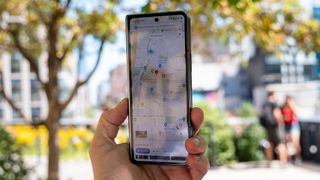Google Maps may soon use satellites even if your phone is offline
Satellite connectivity in Android will do more than just send text messages.

What you need to know
- Google is gearing up to add support for satellite connectivity in Android, and previous leaks have revealed that texts might be made over satellite.
- Now, code referenced in the Google Maps app reveals that Google might also use satellite connectivity to update a user's location.
- The feature might allow users to update their location every 15 minutes, up to five times per day, using satellite connectivity.
Satellite connectivity has been a hot topic in the Android world recently, as all signs point to Google adding the feature to future Android releases and new devices. However, most references to satellite connectivity in Android have been related to text messaging while out of range of a cellular tower. Now, new code references hint at a way to use satellite connectivity in future versions of Android that might even be more useful than texting.
Google Maps will eventually let users update their location using an overhead satellite, according to a report from PiunikaWeb. In a recent Google Maps beta, specifically version v11.125, PiunikaWeb found multiple code snippets describing satellite-enabled location updates. Presumably, users could use this feature to update their location in Google Maps to share with loved ones or first responders if they are off-grid.
The code strings preview a new UI that appears in Google Maps when a user does not have cellular connectivity. If the phone loses cellular data connection, users will see a "Connect to satellite" explainer with a button to use satellite connectivity in Google Maps. After pressing it, Google Maps users can update their location via satellite once every 15 minutes, with a limit of five times per day.

This limit will mean Android users have to choose wisely before falling back to a satellite for location updates. The five-per-day cap likely has to do with the cost of using satellites for things like messaging and location updates. After being sent to an overhead satellite, the data needs to be returned to a ground satellite and processed, which is a costly endeavor for companies.
This is precisely the reason why phone companies that offer satellite connectivity, like Apple, caution that the functionality might not be free forever. Apple guarantees two years of free satellite connectivity, and can extend that free period if it chooses to, but the cost beyond that is to be determined.
While there's a lot of talk about Google's upcoming satellite additions in Android, it's important to remember that there is a hardware component to the functionality. Phones will need to support satellite connectivity in order to take advantage of the software features, and it's expected that the upcoming Pixel 9 will include that hardware.
Be an expert in 5 minutes
Get the latest news from Android Central, your trusted companion in the world of Android

Brady is a tech journalist covering news at Android Central. He has spent the last two years reporting and commenting on all things related to consumer technology for various publications. Brady graduated from St. John's University in 2023 with a bachelor's degree in journalism. When he isn't experimenting with the latest tech, you can find Brady running or watching sports.
-
spARTacus In theory, location services should already be able to work with GPS without the need for the receiver (in this case a phone) to have to send anything to a satellite, a cell tower, or an otherwise network based server/service.Reply -
Mooncatt ReplyspARTacus said:In theory, location services should already be able to work with GPS without the need for the receiver (in this case a phone) to have to send anything to a satellite, a cell tower, or an otherwise network based server/service.
True, but apparently Google is considering the option of limited two way satellite based communication. The OP didn't do a good job explaining it, but the article itself mentions a satellite text option, and a potential new feature that lets you update your location every 15 min with a max of 5 updates per day via satellite communication.
This would be useful for people working, hiking, camping, etc in areas with zero cell signal and no Wi-Fi. If something bad happens requiring emergency services, the phone could transmit your location to the satellite and make it available to others in your family/group to see exactly where you are.
What I wonder is if my phone has enough power to send a signal into space, why doesn't it have the power to send a signal to my local cell tower? -
spARTacus Reply
Like some sort of manual ability to push one's location to something like a google equivalent of FindMyFriends? I guess I wasn't thinking of it like that, given the article's title about google maps. Yes, I did follow the other aspects about the intention for limited two way Android satellite communications, like Apple has.Mooncatt said:...and a potential new feature that lets you update your location every 15 min with a max of 5 updates per day via satellite communication.
This would be useful for people working, hiking, camping, etc in areas with zero cell signal and no Wi-Fi. If something bad happens requiring emergency services, the phone could transmit your location to the satellite and make it available to others in your family/group to see exactly where you are.... -
spARTacus Reply
Probably because the cell towers in such scenarios when one needs to depend on satellite communications, would be over the horizon, not within line of sight.Mooncatt said:...What I wonder is if my phone has enough power to send a signal into space, why doesn't it have the power to send a signal to my local cell tower? -
mustang7757 Reply
I would think a device would need a chip in It that provides satellite service as other phones that don't can't communicate with a satellite.Mooncatt said:True, but apparently Google is considering the option of limited two way satellite based communication. The OP didn't do a good job explaining it, but the article itself mentions a satellite text option, and a potential new feature that lets you update your location every 15 min with a max of 5 updates per day via satellite communication.
This would be useful for people working, hiking, camping, etc in areas with zero cell signal and no Wi-Fi. If something bad happens requiring emergency services, the phone could transmit your location to the satellite and make it available to others in your family/group to see exactly where you are.
What I wonder is if my phone has enough power to send a signal into space, why doesn't it have the power to send a signal to my local cell tower? -
Mooncatt Reply
I'm actually referring to my home where I'm within walking distance of an NFL stadium yet my neighborhood is basically a cellular dead zone.spARTacus said:Probably because the cell towers in such scenarios when one needs to depend on satellite communications, would be over the horizon, not within line of sight.
True. I was working with the understanding that that's what the article was referring to. Not all phones would have the ability. I'm curious how having that ability will impact body size. Pretty sure it requires a fair bit of power to send up to space even just to transmit coordinates or a short text. Plus the extra radio equipment like the transmitter and antenna.mustang7757 said:I would think a device would need a chip in It that provides satellite service as other phones that don't can't communicate with a satellite. -
mustang7757 Reply
Yeah this is from the iPhone 14 , which I have , I'm sure it's very limited for what and how much it can do, then you have to say how useful is it? Because I'm sure you can't be making calls or texting/data for long time , maybe like you mentioned in remote areas just for emergencyMooncatt said:I'm actually referring to my home where I'm within walking distance of an NFL stadium yet my neighborhood is basically a cellular dead zone.True. I was working with the understanding that that's what the article was referring to. Not all phones would have the ability. I'm curious how having that ability will impact body size. Pretty sure it requires a fair bit of power to send up to space even just to transmit coordinates or a short text. Plus the extra radio equipment like the transmitter and antenna.
"The iPhone 14 and 14 Pro models use an internal antenna to connect to a Globalstar satellite when outside of cell service. The phone's Qualcomm X65 cellular modem can send and receive data using Band 54, a frequency used by Globalstar. The iPhone 14 and 15 models come with satellite features for free for two years. To use satellite connectivity, you need to update to the latest version of iOS." -
spARTacus Reply
I think that has to do with where/how the carriers place/point their antennas in relation to combinations of such for other nearby antennas, in relation to where they are expecting massive amounts of customers, and perhaps also about physical obstructions. My guess is there's pretty good coverage inside the stadium when an event is scheduled, and they've not really focused on caring about the nearby neighbourhood.Mooncatt said:I'm actually referring to my home where I'm within walking distance of an NFL stadium yet my neighborhood is basically a cellular dead zone...
